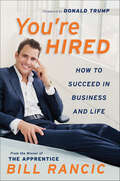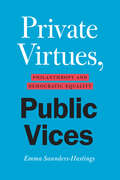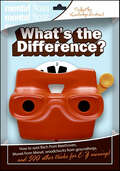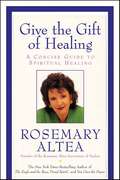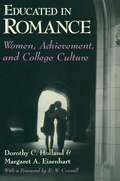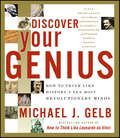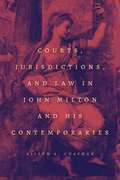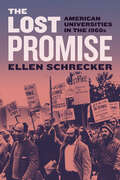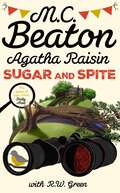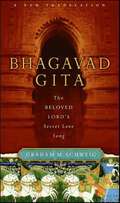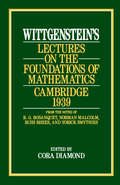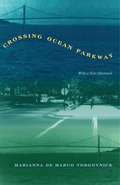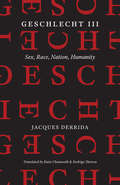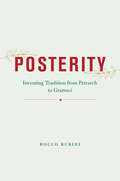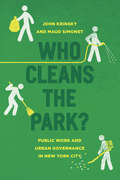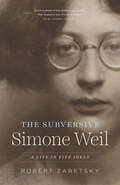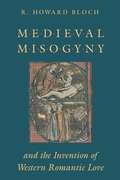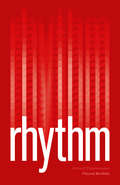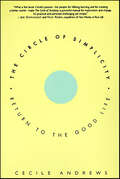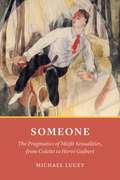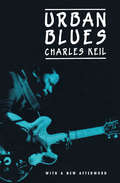- Table View
- List View
You're Hired: How to Succeed in Business and Life
by Bill Rancic*Author will be named after the final show is aired in Australia*The winner of the hit TV show, The Apprentice, shows how anyone can become their own personal success in both business and life, using his or her own experiences as a self-made entrepreneur, his or her work ethic, top business strategies, and lessons learned competing on the show, working for Donald Trump and winning the most talked about reality shows in years.Foreword by Donald Trump.
Private Virtues, Public Vices: Philanthropy and Democratic Equality
by Emma Saunders-HastingsA thought-provoking challenge to our ideas about philanthropy, marking it as a deeply political activity that allows the wealthy to dictate more than we think. Philanthropy plays a huge role in supporting the provision of many public goods in contemporary societies. As a result, decisions that affect public outcomes and people’s diverse interests are often dependent on the preferences and judgments of the rich. Political theorist Emma Saunders-Hastings argues that philanthropy is a deeply political activity. She asks readers to look at how the power wielded by philanthropy impacts democracy and deepens political inequality by enabling the wealthy to exercise outsize influence in public life and by putting in place paternalistic relationships between donors and their intended beneficiaries. If philanthropy is to be made compatible with a democratic society of equals, it must be judged not simply on the benefits it brings but on its wider political consequences. Timely and thought-provoking, Private Virtues, Public Vices will challenge readers’ thoughts on what philanthropy is and how it truly affects us.
What's the Difference?: What's the Difference?
by Editors of Mental FlossEnlighten Up Already!Monet? Manet? Who can even tell the difference? Well, with the help of the newest mental_floss tome, you can! Want to learn how to tell egg rolls from spring rolls, nuclear bombs from dirty nuclear bombs, or even how to tell an idiot from a moron (there's a real scientific difference)? Piece of cake! Whether you're trying to impress your boss, your mother-in-law, attractive singles, or a pack of fourth graders (you know how they love semantics), mental_floss gives you all the tips and tricks to have you sounding like a genius.
Give the Gift of Healing: A Concise Guide to Spiritual Healing
by Rosemary AlteaFrom The New York Times bestselling author of The Eagle and the Rose and Proud Spirit comes a book on spiritual healing.Rosemary Altea, the internationally renowned medium known to millions worldwide as "The Voice of the Spirit World," is also the founder of the Rosemary Altea Association of Healers, a charitable organization with patients worldwide. In this book package, Rosemary offers an introduction to spiritual healing, beginning with a personal account of how she embraced her role as a healer sixteen years ago. Sharing her belief that sickness and pain can cause the soul to live in a dark place, Rosemary presents healing techniques designed to give light - the Seven Steps to Self-Healing. We meet two inspiring patients who have been treated by Rosemary and her team of healers, and we learn how we can harness the power of our own thoughts and use color energy visualizations to achieve inner peace. Also included is a color chart explaining how each of eight vibrant hues can give us the gift of healing.
Educated in Romance: Women, Achievement, and College Culture
by Dorothy C. Holland Margaret A. EisenhartIs romance more important to women in college than grades are? Why do so many women enter college with strong academic backgrounds and firm career goals but leave with dramatically scaled-down ambitions? Dorothy C. Holland and Margaret A. Eisenhart expose a pervasive "culture of romance" on campus: a high-pressure peer system that propels women into a world where their attractiveness to men counts most.
Discover Your Genius: How to Think Like History's Ten Most Revolutionary Minds
by Michael J. GelbUnleash your creative potential.Michael J. Gelb, bestselling author of How to Think Like Leonardo da Vinci, draws upon history's most revolutionary minds to help you unleash your own creativity. With fascinating biographies of all ten geniuses, personal self-assessments, and practical exercises, this book is the key to unlocking the genius inside you!Plato -- Deepening your love of wisdomFilippo Brunelleschi -- Expanding your perspectiveChristopher Columbus -- Strengthening your vision, optimism, and courage Nicolaus Copernicus -- Reorganizing your vision of the worldQueen Elizabeth I -- Wielding your power with balance and effectivenessWilliam Shakespeare -- Cultivating your emotional intelligenceThomas Jefferson -- Celebrating your freedom in the pursuit of happinessCharles Darwin -- Developing your powers of observation and cultivating an open mindMahatma Gandhi -- Applying the principles of spiritual genius to harmonize spirit, mind, and bodyAlbert Einstein -- Unleashing your imagination and "combinatory play"
Courts, Jurisdictions, and Law in John Milton and His Contemporaries
by Alison A. ChapmanJohn Milton is widely known as the poet of liberty and freedom. But his commitment to justice has been often overlooked. As Alison A. Chapman shows, Milton’s many prose works are saturated in legal ways of thinking, and he also actively shifts between citing Roman, common, and ecclesiastical law to best suit his purpose in any given text. This book provides literary scholars with a working knowledge of the multiple, jostling, real-world legal systems in conflict in seventeenth-century England and brings to light Milton’s use of the various legal systems and vocabularies of the time—natural versus positive law, for example—and the differences between them. Surveying Milton’s early pamphlets, divorce tracts, late political tracts, and major prose works in comparison with the writings and cases of some of Milton’s contemporaries—including George Herbert, John Donne, Ben Jonson, and John Bunyan—Chapman reveals the variety and nuance in Milton’s juridical toolkit and his subtle use of competing legal traditions in pursuit of justice.
The Lost Promise: American Universities in the 1960s
by Ellen SchreckerThe Lost Promise is a magisterial examination of the turmoil that rocked American universities in the 1960s, with a unique focus on the complex roles played by professors as well as students. The 1950s through the early 1970s are widely seen as American academia’s golden age, when universities—well-funded and viewed as essential for national security, economic growth, and social mobility—embraced an egalitarian mission. Swelling in size, schools attracted new types of students and professors, including radicals who challenged their institutions’ calcified traditions. But that halcyon moment soon came to a painful and confusing end, with consequences that still afflict the halls of ivy. In The Lost Promise, Ellen Schrecker—our foremost historian of both the McCarthy era and the modern American university—delivers a far-reaching examination of how and why it happened. Schrecker illuminates how US universities’ explosive growth intersected with the turmoil of the 1960s, fomenting an unprecedented crisis where dissent over racial inequality and the Vietnam War erupted into direct action. Torn by internal power struggles and demonized by conservative voices, higher education never fully recovered, resulting in decades of underfunding and today’s woefully inequitable system. As Schrecker’s magisterial history makes blazingly clear, the complex blend of troubles that disrupted the university in that pivotal period haunts the ivory tower to this day.
Agatha Raisin: Sugar and Spite
by M.C. Beaton with R.W. GreenFeathers are flying in Agatha Raisin's brand new case! <p> Agatha Raisin can think of nothing duller than a lecture on birdwatching... but events take a thrilling turn when an angry interloper storms the stage at the Carsely Ladies' Society and threatens the three bird fanatics. <p> When Agatha walks in on the trio of women in the middle of a blazing row, her detective instincts start 'twitching'. And when one of the birdwatchers is found dead, she can't resist investigating. <P> Her first lead comes from the victim's brother, who believes his sister was murdered by her fellow twitchers. Further digging reveals the disturbing nature of the women's friendship, and a bewilderingly long list of suspects. <P> Agatha will have to break out her binoculars and embrace her bitter side to solve the murders. Will she be able to gather all the breadcrumbs and put together the clues before she becomes a sitting duck herself?
The The Ironies of Affirmative Action: Politics, Culture, and Justice in America (Morality and Society Series)
by John D. SkrentnyAffirmative action has been fiercely debated for more than a quarter of a century, producing much partisan literature, but little serious scholarship and almost nothing on its cultural and political origins. The Ironies of Affirmative Action is the first book-length, comprehensive, historical account of the development of affirmative action. Analyzing both the resistance from the Right and the support from the Left, Skrentny brings to light the unique moral culture that has shaped the affirmative action debate, allowing for starkly different policies for different citizens. He also shows, through an analysis of historical documents and court rulings, the complex and intriguing political circumstances which gave rise to these controversial policies. By exploring the mystery of how it took less than five years for a color-blind policy to give way to one that explicitly took race into account, Skrentny uncovers and explains surprising ironies: that affirmative action was largely created by white males and initially championed during the Nixon administration; that many civil rights leaders at first avoided advocacy of racial preferences; and that though originally a political taboo, almost no one resisted affirmative action. With its focus on the historical and cultural context of policy elites, The Ironies of Affirmative Action challenges dominant views of policymaking and politics.
Bhagavad Gita: The Beloved Lord's Secret Love Song
by Graham M. SchweigAn elegant, highly accessible new English translation of the classic Hindu text, one of the most important sacred scriptures in world religion.The Bhagavad Gita is often regarded as the Bible of India. With a gripping story and deeply compelling message, it is unquestionably one of the most popular sacred texts of Asia and, along with the Bible and the Qur’an, one of the most important holy scriptures in the world.Part of an ancient Hindu epic poem, the dialogue of the Bhagavad Gita takes place on a battlefield, where a war for the possession of a North Indian kingdom is about to ensue between two noble families related by blood. The epic’s hero, young Prince Arjuna, is torn between his duty as a warrior and his revulsion at the thought of his brothers and cousins killing each other over control of the realm. Frozen by this ethical dilemma, he debates the big questions of life and death with the supreme Hindu deity Krishna, cleverly disguised as his charioteer. By the end of the story, Eastern beliefs about mortality and reincarnation, the vision and practice of yoga, the Indian social order and its responsibilities, family loyalty, spiritual knowledge, and the loftiest pursuits of the human heart are explored in depth. Explaining the very purpose of life and existence, this classic has stood the test of twenty-three centuries. It is presented here in a thoroughly accurate, illuminating, and beautiful translation that is sure to become the standard for our day.“Schweig’s new, beautiful, and accessible translation of the Gita will remain the standard text of this marvelous Song for years to come.” —Huston Smith, author of The World’s Religions“Crystal clear and eminently readable.” —Ariel Glucklich, Professor of Theology (Hinduism) at Georgetown University
Wittgenstein's Lectures on the Foundations of Mathematics, Cambridge, 1939
by Cora DiamondFor several terms at Cambridge in 1939, Ludwig Wittgenstein lectured on the philosophical foundations of mathematics. A lecture class taught by Wittgenstein, however, hardly resembled a lecture. He sat on a chair in the middle of the room, with some of the class sitting in chairs, some on the floor. He never used notes. He paused frequently, sometimes for several minutes, while he puzzled out a problem. He often asked his listeners questions and reacted to their replies. Many meetings were largely conversation. These lectures were attended by, among others, D. A. T. Gasking, J. N. Findlay, Stephen Toulmin, Alan Turing, G. H. von Wright, R. G. Bosanquet, Norman Malcolm, Rush Rhees, and Yorick Smythies. Notes taken by these last four are the basis for the thirty-one lectures in this book. The lectures covered such topics as the nature of mathematics, the distinctions between mathematical and everyday languages, the truth of mathematical propositions, consistency and contradiction in formal systems, the logicism of Frege and Russell, Platonism, identity, negation, and necessary truth. The mathematical examples used are nearly always elementary.
Crossing Ocean Parkway
by Marianna De Marco TorgovnickGrowing up an Italian-American in the Bensonhurst neighborhood of New York city, Marianna De Marco longed for college, culture, and upward mobility. Her daydreams circled around WASP (White Anglo Saxon Protestant) heroes on television—like Robin Hood and the Cartwright family—but in Brooklyn she never encountered any. So she associated moving up with Ocean Parkway, a street that divides the working-class Italian neighborhood where she was born from the middle-class Jewish neighborhood into which she married. This book is Torgovnick's unflinching account of crossing cultural boundaries in American life, of what it means to be an Italian American woman who became a scholar and literary critic. Included are autobiographical moments interwoven with engrossing interpretations of American cultural icons from Dr. Dolittle to Lionel Trilling, The Godfather to Camille Paglia. Her experiences allow her to probe the cultural tensions in America caused by competing ideas of individuality and community, upward mobility and ethnic loyalty, acquisitiveness and spirituality.
Geschlecht III: Sex, Race, Nation, Humanity
by Jacques DerridaA significant event in Derrida scholarship, this book marks the first publication of his long-lost philosophical text known only as “Geschlecht III.” The third, and arguably the most significant, piece in his four-part Geschlecht series, it fills a gap that has perplexed Derrida scholars. The series centers on Martin Heidegger and the enigmatic German word Geschlecht, which has several meanings pointing to race, sex, and lineage. Throughout the series, Derrida engages with Heidegger’s controversial oeuvre to tease out topics of sexual difference, nationalism, race, and humanity. In Geschlecht III, he calls attention to Heidegger’s problematic nationalism, his work’s political and sexual themes, and his promise of salvation through the coming of the “One Geschlecht,” a sentiment that Derrida found concerningly close to the racial ideology of the Nazi party. Amid new revelations about Heidegger’s anti-Semitism and the contemporary context of nationalist resurgence, this third piece of the Geschlecht series is timelier and more necessary than ever. Meticulously edited and expertly translated, this volume brings Derrida’s mysterious and much awaited text to light.
Economic Development: The History of an Idea
by H.W. Arndt"Economic Development makes an important contribution of the literature on economic development, especially as it incorporates ideas on a theme that informs our concern for social justice, individual and social freedom, identify, and community."—Winston E. Langley, Annals of the American Academy of Political and Social Science
Posterity: Inventing Tradition from Petrarch to Gramsci
by Rocco RubiniReading a range of Italian works, Rubini considers the active transmittal of traditions through generations of writers and thinkers. Rocco Rubini studies the motives and literary forms in the making of a “tradition,” not understood narrowly, as the conservative, stubborn preservation of received conventions, values, and institutions, but instead as the deliberate effort on the part of writers to transmit a reformulated past across generations. Leveraging Italian thinkers from Petrarch to Gramsci, with stops at prominent humanists in between—including Giambattista Vico, Carlo Goldoni, Francesco De Sanctis, and Benedetto Croce—Rubini gives us an innovative lens through which to view an Italian intellectual tradition that is at once premodern and modern, a legacy that does not depend on a date or a single masterpiece, but instead requires the reader to parse an expanse of writings to uncover deeper transhistorical continuities that span six hundred years. Whether reading work from the fourteenth century, or from the 1930s, Rubini elucidates the interplay of creation and the reception underlying the enactment of tradition, the practice of retrieving and conserving, and the revivification of shared themes and intentions that connect thinkers across time. Building on his award-winning book, The Other Renaissance, this will prove a valuable contribution for intellectual historians, literary scholars, and those invested in the continuing humanist legacy.
Who Cleans the Park?: Public Work and Urban Governance in New York City
by John Krinsky Maud SimonetAmerica’s public parks are in a golden age. Hundreds of millions of dollars—both public and private—fund urban jewels like Manhattan’s Central Park. Keeping the polish on landmark parks and in neighborhood playgrounds alike means that the trash must be picked up, benches painted, equipment tested, and leaves raked. Bringing this often-invisible work into view, however, raises profound questions for citizens of cities. In Who Cleans the Park? John Krinsky and Maud Simonet explain that the work of maintaining parks has intersected with broader trends in welfare reform, civic engagement, criminal justice, and the rise of public-private partnerships. Welfare-to-work trainees, volunteers, unionized city workers (sometimes working outside their official job descriptions), staff of nonprofit park “conservancies,” and people sentenced to community service are just a few of the groups who routinely maintain parks. With public services no longer being provided primarily by public workers, Krinsky and Simonet argue, the nature of public work must be reevaluated. Based on four years of fieldwork in New York City, Who Cleans the Park? looks at the transformation of public parks from the ground up. Beginning with studying changes in the workplace, progressing through the public-private partnerships that help maintain the parks, and culminating in an investigation of a park’s contribution to urban real-estate values, the book unearths a new urban order based on nonprofit partnerships and a rhetoric of responsible citizenship, which at the same time promotes unpaid work, reinforces workers’ domination at the workplace, and increases the value of park-side property. Who Cleans the Park? asks difficult questions about who benefits from public work, ultimately forcing us to think anew about the way we govern ourselves, with implications well beyond the five boroughs.
A Great and Rising Nation: Naval Exploration and Global Empire in the Early US Republic (American Beginnings, 1500-1900 Ser.)
by Michael A. VerneyA Great and Rising Nation illuminates the unexplored early decades of the United States’ imperialist naval aspirations. Conventional wisdom holds that, until the Spanish-American War of 1898, the United States was a feeble player on the world stage, with an international presence rooted in commerce rather than military might. Michael A. Verney’s A Great and Rising Nation flips this notion on its head, arguing that early US naval expeditions, often characterized as merely scientific, were in fact deeply imperialist. Circling the globe from the Mediterranean to South America and the Arctic, these voyages reflected the diverse imperial aspirations of the new republic, including commercial dominance in the Pacific World, religious empire in the Holy Land, proslavery expansion in South America, and diplomatic prestige in Europe. As Verney makes clear, the United States had global imperial aspirations far earlier than is commonly thought.
Sensuous Burgundy
by Barbara DelinskyFrom New York Times bestselling author Barbara Delinsky comes an emotional battle of wits, will, and passion, first published in 1996.A legal powerhouse, Assistant District Attorney Laura Grandine stares across the aisle at her opponent, Maxwell Kraig, the renowned big-city lawyer imported to her small Massachusetts town to act as the defense for the accused. Tough and talented, Laura has always fought hard for every victory, and she knows that she has found a worthy adversary in the skilled and charismatic Kraig, a man whose fiery spirit and need to win match her own.But their intense passions will not be confined to the courtroom—as outside, a furious contest rages between them, one that could lead to incomparable joy . . . or unbearable heartbreak. Because, beneath her hard exterior, Laura Grandine is a woman who aches to love and be loved. But it must be on her own terms.
The Subversive Simone Weil: A Life in Five Ideas
by Robert ZaretskyThis exploration of the contradictary philosopher is “a beautifully sharp and thoughtful account of her life and work—a fascinating read” (Sarah Bakewell, New York Times–bestselling author).Known as the “patron saint of all outsiders,” Simone Weil (1909–43) was one of the twentieth century's most remarkable thinkers, a philosopher who truly lived by her political and ethical ideals. In a short life framed by the two world wars, Weil taught philosophy to lycée students and organized union workers, fought alongside anarchists during the Spanish Civil War and labored alongside workers on assembly lines, joined the Free French movement in London and died in despair because she was not sent to France to help the Resistance.Though Weil published little during her life, after her death, thanks largely to the efforts of Albert Camus, hundreds of pages of her manuscripts were published to critical and popular acclaim. While many seekers have been attracted to Weil's religious thought, Robert Zaretsky gives us a different Weil, exploring her insights into politics and ethics, and showing us a new side of Weil that balances her contradictions—the rigorous rationalist who also had her own brand of Catholic mysticism; the revolutionary with a soft spot for anarchism yet who believed in the hierarchy of labor; and the humanitarian who emphasized human needs and obligations over human rights. Reflecting on the relationship between thought and action in Weil's life, The Subversive Simone Weil honors the complexity of Weil's thought and speaks to why it matters and continues to fascinate readers today.
Medieval Misogyny and the Invention of Western Romantic Love
by R. Howard BlochUntil now the advent of Western romantic love has been seen as a liberation from—or antidote to—ten centuries of misogyny. In this major contribution to gender studies, R. Howard Bloch demonstrates how similar the ubiquitous antifeminism of medieval times and the romantic idealization of woman actually are. Through analyses of a broad range of patristic and medieval texts, Bloch explores the Christian construction of gender in which the flesh is feminized, the feminine is aestheticized, and aesthetics are condemned in theological terms. Tracing the underlying theme of virginity from the Church Fathers to the courtly poets, Bloch establishes the continuity between early Christian antifeminism and the idealization of woman that emerged in the twelfth and thirteenth centuries. In conclusion he explains the likely social, economic, and legal causes for the seeming inversion of the terms of misogyny into those of an idealizing tradition of love that exists alongside its earlier avatar until the current era. This startling study will be of great value to students of medieval literature as well as to historians of culture and gender.
Rhythm: Form & Dispossession
by Vincent BarlettaMore than the persistent beat of a song or the structural frame of poetry, rhythm is a deeply imbedded force that drives our world and is also a central component of the condition of human existence. It’s the pulse of the body, a power that orders matter, a strange and natural force that flows through us. Virginia Woolf describes it as a “wave in the mind” that carries us, something we can no more escape than we could stop our hearts from beating. Vincent Barletta explores rhythm through three historical moments, each addressing it as a phenomenon that transcends poetry, aesthetics, and even temporality. He reveals rhythm to be a power that holds us in place, dispossesses us, and shapes the foundations of our world. In these moments, Barletta encounters rhythm as a primordial and physical binding force that establishes order and form in the ancient world, as the anatomy of lived experience in early modern Europe, and as a subject of aesthetic and ethical questioning in the twentieth century. A wide-ranging book covering a period spanning two millennia and texts from over ten languages, Rhythm will expand the conversation around this complex and powerful phenomenon.
The Circle of Simplicity: Return to the Good Life
by Cecile AndrewsDiscover how to create a better life for yourself through voluntary simplicity—rushing less, working less, and spending less.“Stressed out? Overworked? Spending too much, or just concerned about the effect of your lifestyle on the environment? Buy (or borrow) The Circle of Simplicity now. Spend the next few hours reading it, preferably in your neighborhood café (in true Cecile Andrews style). It is an eloquent, passionate, well-written, funny book. I couldn’t put it down.” —Juliet Schor, author of The Overworked AmericanFor a growing number of people, simplicity has been a path to experience the joy in life, to cherish its richness and vitality. It strips away the burdens of our daily lives so that we are left with exhilaration, spirit and fullness. These people are finding that less—less work, less rushing, less debt—is more—more time with family and friends, more time with community, more time with nature, and more time to develop a meaningful and compelling spirituality.In The Circle of Simplicity: Return to the Good Life, author Cecile Andrews helps you discover and create the good life for yourself. She is renowned for her workshops on voluntary simplicity and her seminars on creating simplicity circles, where people explore their own life stories and share information and knowledge, helping one another develop lives of simplicity and satisfaction. The circles not only give people the tools to change, but they also fill unmet needs for community and intimacy and the desire to search for truth in the company of kindred spirits.“What a fine book. Cecile’s passion—for people, for lifelong learning, and for creating a better world—makes The Circle of Simplicity a powerful manual for exploration and change. It’s practical and personal, challenging yet simple.” —Joe Dominguez and Vicki Robin, coauthors of Your Money or Your Life
Someone: The Pragmatics of Misfit Sexualities, from Colette to Hervé Guibert
by Michael LuceyImagine trying to tell someone something about yourself and your desires for which there are no words. What if the mere attempt at expression was bound to misfire, to efface the truth of that ineluctable something? In Someone, Michael Lucey considers characters from twentieth-century French literary texts whose sexual forms prove difficult to conceptualize or represent. The characters expressing these “misfit” sexualities gravitate towards same-sex encounters. Yet they differ in subtle but crucial ways from mainstream gay or lesbian identities—whether because of a discordance between gender identity and sexuality, practices specific to a certain place and time, or the fleetingness or non-exclusivity of desire. Investigating works by Simone de Beauvoir, Colette, Jean Genet, and others, Lucey probes both the range of same-sex sexual forms in twentieth-century France and the innovative literary language authors have used to explore these evanescent forms. As a portrait of fragile sexualities that involve awkward and delicate maneuvers and modes of articulation, Someone reveals just how messy the ways in which we experience and perceive sexuality remain, even to ourselves.
Urban Blues
by Charles KeilCharles Keil examines the expressive role of blues bands and performers and stresses the intense interaction between performer and audience. Profiling bluesmen Bobby Bland and B. B. King, Keil argues that they are symbols for the black community, embodying important attitudes and roles—success, strong egos, and close ties to the community. While writing Urban Blues in the mid-1960s, Keil optimistically saw this cultural expression as contributing to the rising tide of raised political consciousness in Afro-America. His new Afterword examines black music in the context of capitalism and black culture in the context of worldwide trends toward diversification. "Enlightening. . . . [Keil] has given a provocative indication of the role of the blues singer as a focal point of ghetto community expression."—John S. Wilson, New York Times Book Review"A terribly valuable book and a powerful one. . . . Keil is an original thinker and . . . has offered us a major breakthrough."—Studs Terkel, Chicago Tribune "[Urban Blues] expresses authentic concern for people who are coming to realize that their past was . . . the source of meaningful cultural values."—Atlantic "An achievement of the first magnitude. . . . He opens our eyes and introduces a world of amazingly complex musical happening."—Robert Farris Thompson, Ethnomusicology "[Keil's] vigorous, aggressive scholarship, lucid style and sparkling analysis stimulate the challenge. Valuable insights come from treating urban blues as artistic communication."—James A. Bonar, Boston Herald
